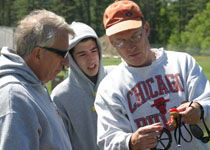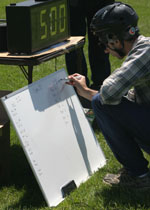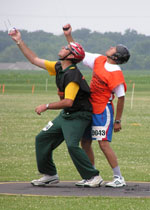Although Labor Day weekend symbolizes the end of summer, the combat season is still in full swing. Here in New England, we still
have several more contests scheduled extending into early November, including two one-airplane F2D events. The first event is to
take place at the NEST Mass Cup in Wrentham, MA on September 26. The second event is going to be a triple elimination event at the
Wingbusters’ field in Middleboro, MA on October 23 or 24, depending on the weather forecast. As this event was just recently scheduled,
I wanted to take this opportunity to advertise it around for anyone who might want to attend. If you’re interested in coming, please
contact me or Neil Simpson so we can keep you updated on the plan.
Labor Day weekend symbolizes the end of summer, the combat season is still in full swing. Here in New England, we still
have several more contests scheduled extending into early November, including two one-airplane F2D events. The first event is to
take place at the NEST Mass Cup in Wrentham, MA on September 26. The second event is going to be a triple elimination event at the
Wingbusters’ field in Middleboro, MA on October 23 or 24, depending on the weather forecast. As this event was just recently scheduled,
I wanted to take this opportunity to advertise it around for anyone who might want to attend. If you’re interested in coming, please
contact me or Neil Simpson so we can keep you updated on the plan.
In other news, the F2D News recently went online with a brand new website for your surfing enjoyment.
Over the past few months I became aware of the fact that people in a much wider area than New England have been reading these news columns.
While the focus has always been on F2D in New England, I think that much of what I have written has been applicable to a more general audience.
Keeping this in mind, I plan to continue writing with an emphasis on New England, but hope to include as much generally applicable information
as possible. All of the previous columns are available in the F2D News Archive on the web site, as well as a handful of useful links,
documents, and informational guides/articles on the “Resources” page. Most recently, I have added an informational guide on measuring, setting,
and understanding engine head clearances. Even if you don’t feel comfortable opening up and monkeying with your engines, I hope you will
give it a read – you may find it interesting.
 In the rest of this column I’ll take a little time to discuss the one-airplane “F2D-style” event currently being flown in New England.
Variations of this event are flown around the country, and as this is the first time that I’ve been involved with consistently running
contests of this type I’ll share some of the things that I’ve learned from the process. Neil Simpson spoke with some of the guys from
Lubbock, TX at the Nats this summer and gained some insight from their take on this event which I will also try to include here.
In the rest of this column I’ll take a little time to discuss the one-airplane “F2D-style” event currently being flown in New England.
Variations of this event are flown around the country, and as this is the first time that I’ve been involved with consistently running
contests of this type I’ll share some of the things that I’ve learned from the process. Neil Simpson spoke with some of the guys from
Lubbock, TX at the Nats this summer and gained some insight from their take on this event which I will also try to include here.
Last Fall, we started running this event by using slow combat rules with F2D equipment and minor variations on the scoring (4 minute
match with one minute starting period, 2 meter center circle). After running a few contests this way in an area where most guys are
not that used to AMA rules to begin with, I noticed some things that are a bit dysfunctional about these (AMA) rules. Specifically,
what I have in mind is the rules surrounding midair collisions and flyable/unflyable aircraft. On the surface, the rule that the match
ends in the event of a midair rendering one or both models unflyable seems quite simple and clear-cut. Actually implementing this rule
is quite another matter, as a thorough inspection of a downed model is required in order to make the flyable/unflyable determination.
In the meantime, one pilot may still be flying and accruing airtime, which means that an extra watch must be employed to keep track of
the difference and roll back the time if an unflyable verdict is reached. All of this leads to a lot of hassle and many opportunities
for judging mishaps. There is a widely held (but in my opinion unsubstantiated) belief that the rules of F2D are generally too numerous
and complicated; this is a case where AMA rules lose big comparatively speaking.
 To get around this problem, we’ve gone with the simplest solution of all (and, in fact, the one taken by F2D) – in the event of a midair
collision, the match continues on as if one or both models had simply hit the ground. There are several reasons why this approach seems
to be better than the old way. First, judging is much simpler, and there is less chance for mistakes or disputes. Second, the incentive
to get ahead in the match and then try to cause a midair collision to end the match is considerably reduced. Our intent in running/flying
this event is really to give everyone as much flying practice as possible, and on average it appears that this rule is at least as fair to
all pilots concerned as the AMA flyable/unflyable rule and results in at least as much combat being flown.
To get around this problem, we’ve gone with the simplest solution of all (and, in fact, the one taken by F2D) – in the event of a midair
collision, the match continues on as if one or both models had simply hit the ground. There are several reasons why this approach seems
to be better than the old way. First, judging is much simpler, and there is less chance for mistakes or disputes. Second, the incentive
to get ahead in the match and then try to cause a midair collision to end the match is considerably reduced. Our intent in running/flying
this event is really to give everyone as much flying practice as possible, and on average it appears that this rule is at least as fair to
all pilots concerned as the AMA flyable/unflyable rule and results in at least as much combat being flown.
Another issue we’ve had to deal with is the scoring of air time. In F2D, one point is added for every second that a pilot is airborne, and
one point is subtracted for every second that he/she stays on the ground. The minus points create a bigger incentive for both pilots to stay
in the air. However, this system is a little too harsh when only one model is allowed per pilot as typical pitting times are greatly increased.
To account for this, we first eliminated the minus points from the F2D scoring. It then became apparent that in a 4 minute match all one needs
to secure a win is two quick cuts and 40 seconds of air time. Again this is not a very good situation, and does not provide enough reward for
staying in the air.
To solve this problem, we took the advice of the Lubbock crew and decreased the number of points awarded per cut from 100 to 60. This
renormalization is necessary to recapture the proper relative weighting between getting cuts and staying airborne when the total match
time is only 4 minutes instead of 5. As an additional bonus, tallying up the scores is extremely simple in this system as everything
can be done in base 60 – a cut is equivalent to one minute of airtime. Adding up the scores at the end of the match can be done with
almost no mental effort.
Our last one-airplane F2D-style contest was run using these modifications to the rules, and everything appeared to go quite well. The
renormalized scoring seemed to make the match outcomes better reflect the quality of flying, and the removal of the midair rules made
judging much simpler. There is no substitute for flying by-the-book F2D combat; the one airplane format still suffers from reduced average
flying-time per match and the lack of quick pitting that can’t be overcome without switching over to two airplanes per match. However, this
event can serve as a good training event to work on flying skills, have fun, and to prepare somewhat for real F2D with a considerably lower
man-power and equipment requirements.
the one airplane format still suffers from reduced average
flying-time per match and the lack of quick pitting that can’t be overcome without switching over to two airplanes per match. However, this
event can serve as a good training event to work on flying skills, have fun, and to prepare somewhat for real F2D with a considerably lower
man-power and equipment requirements.
Our current rules for this event are spelled out in detail in a document available in the “Resources” section on the new F2D News website.
I invite everyone to take a look at those and check back periodically for updates. Next month I’d like to try to do another Q&A column where
I answer the questions that have been burning in you the readers’ minds. Please contact me or Neil if there are any issues you’d like to see
addressed in the next column and I’ll do my best to provide a response. Happy flying!
 Labor Day weekend symbolizes the end of summer, the combat season is still in full swing. Here in New England, we still
have several more contests scheduled extending into early November, including two one-airplane F2D events. The first event is to
take place at the NEST Mass Cup in Wrentham, MA on September 26. The second event is going to be a triple elimination event at the
Wingbusters’ field in Middleboro, MA on October 23 or 24, depending on the weather forecast. As this event was just recently scheduled,
I wanted to take this opportunity to advertise it around for anyone who might want to attend. If you’re interested in coming, please
contact me or Neil Simpson so we can keep you updated on the plan.
Labor Day weekend symbolizes the end of summer, the combat season is still in full swing. Here in New England, we still
have several more contests scheduled extending into early November, including two one-airplane F2D events. The first event is to
take place at the NEST Mass Cup in Wrentham, MA on September 26. The second event is going to be a triple elimination event at the
Wingbusters’ field in Middleboro, MA on October 23 or 24, depending on the weather forecast. As this event was just recently scheduled,
I wanted to take this opportunity to advertise it around for anyone who might want to attend. If you’re interested in coming, please
contact me or Neil Simpson so we can keep you updated on the plan.
 In the rest of this column I’ll take a little time to discuss the one-airplane “F2D-style” event currently being flown in New England.
Variations of this event are flown around the country, and as this is the first time that I’ve been involved with consistently running
contests of this type I’ll share some of the things that I’ve learned from the process. Neil Simpson spoke with some of the guys from
Lubbock, TX at the Nats this summer and gained some insight from their take on this event which I will also try to include here.
In the rest of this column I’ll take a little time to discuss the one-airplane “F2D-style” event currently being flown in New England.
Variations of this event are flown around the country, and as this is the first time that I’ve been involved with consistently running
contests of this type I’ll share some of the things that I’ve learned from the process. Neil Simpson spoke with some of the guys from
Lubbock, TX at the Nats this summer and gained some insight from their take on this event which I will also try to include here.
 To get around this problem, we’ve gone with the simplest solution of all (and, in fact, the one taken by F2D) – in the event of a midair
collision, the match continues on as if one or both models had simply hit the ground. There are several reasons why this approach seems
to be better than the old way. First, judging is much simpler, and there is less chance for mistakes or disputes. Second, the incentive
to get ahead in the match and then try to cause a midair collision to end the match is considerably reduced. Our intent in running/flying
this event is really to give everyone as much flying practice as possible, and on average it appears that this rule is at least as fair to
all pilots concerned as the AMA flyable/unflyable rule and results in at least as much combat being flown.
To get around this problem, we’ve gone with the simplest solution of all (and, in fact, the one taken by F2D) – in the event of a midair
collision, the match continues on as if one or both models had simply hit the ground. There are several reasons why this approach seems
to be better than the old way. First, judging is much simpler, and there is less chance for mistakes or disputes. Second, the incentive
to get ahead in the match and then try to cause a midair collision to end the match is considerably reduced. Our intent in running/flying
this event is really to give everyone as much flying practice as possible, and on average it appears that this rule is at least as fair to
all pilots concerned as the AMA flyable/unflyable rule and results in at least as much combat being flown.
 the one airplane format still suffers from reduced average
flying-time per match and the lack of quick pitting that can’t be overcome without switching over to two airplanes per match. However, this
event can serve as a good training event to work on flying skills, have fun, and to prepare somewhat for real F2D with a considerably lower
man-power and equipment requirements.
the one airplane format still suffers from reduced average
flying-time per match and the lack of quick pitting that can’t be overcome without switching over to two airplanes per match. However, this
event can serve as a good training event to work on flying skills, have fun, and to prepare somewhat for real F2D with a considerably lower
man-power and equipment requirements.